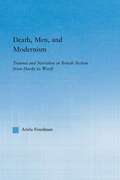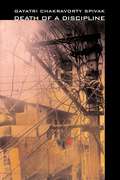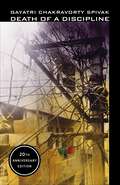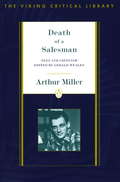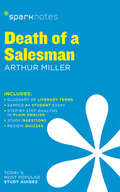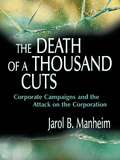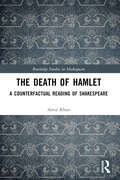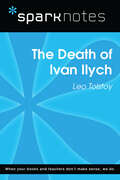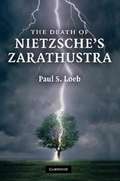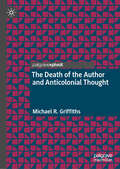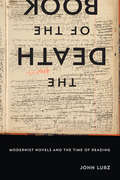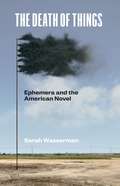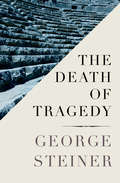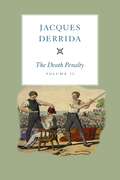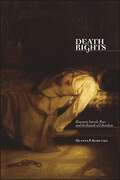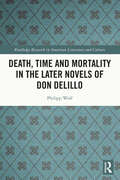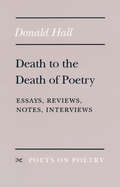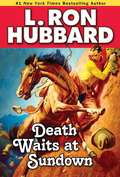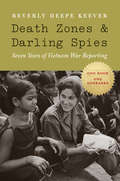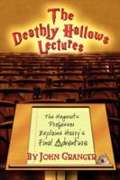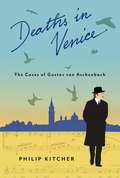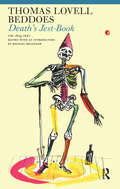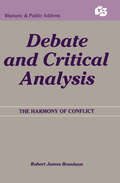- Table View
- List View
Death, Men, and Modernism: Trauma and Narrative in British Fiction from Hardy to Woolf (Literary Criticism and Cultural Theory)
by Ariela FreedmanDeath, Men and Modernism argues that the figure of the dead man becomes a locus of attention and a symptom of crisis in British writing of the early to mid-twentieth century. While Victorian writers used dying women to dramatize aesthetic, structural, and historical concerns, modernist novelists turned to the figure of the dying man to exemplify concerns about both masculinity and modernity. Along with their representations of death, these novelists developed new narrative techniques to make the trauma they depicted palpable. Contrary to modernist genealogies, the emergence of the figure of the dead man in texts as early as Thomas Hardy's Jude the Obscure suggests that World War I intensified-but did not cause-these anxieties. This book elaborates a nodal point which links death, masculinity, and modernity long before the events of World War I.
Death of a Discipline
by Spivak Gayatri ChakravortySpivak demonstrates how critics interested in social justice should pay close attention to literary form and offers new interpretations of classics such as Joseph Conrad's Heart of Darkness and Virginia Woolf's A Room of One's Own. The book offers close readings of texts not only in English, French, and German, but also in Arabic and Bengali.
Death of a Discipline (The Wellek Library Lectures)
by Gayatri Chakravorty SpivakFor almost three decades, Gayatri Chakravorty Spivak has been ignoring the standardized "rules" of the academy and trespassing across disciplinary boundaries. Today she remains one of the foremost figures in the study of world literature and its cultural consequences. In this new book she declares the death of comparative literature as we know it and sounds an urgent call for a "new comparative literature," in which the discipline is given new life—one that is not appropriated and determined by the market.In the era of globalization, when mammoth projects of world literature in translation are being undertaken in the United States, how can we protect the multiplicity of languages and literatures at the university? Spivak demonstrates how critics interested in social justice should pay close attention to literary form and offers new interpretations of classics such as Joseph Conrad's Heart of Darkness and Virginia Woolf's A Room of One's Own. Through close readings of texts not only in English, French, and German but also in Arabic and Bengali, Spivak practices what she preaches.Acclaim for Gayatri Chakravorty Spivak and her work:"[Spivak] pioneered the study in literary theory of non-Western women."—Edward W. Said"She has probably done more long-term political good, in pioneering feminist and post-colonial studies within global academia, than almost any of her theoretical colleagues." —Terry Eagleton"A celebrity in academia... create[s] a stir wherever she goes." —The New York Times
Death of a Discipline: Twentieth Anniversary Edition (The Wellek Library Lectures)
by Gayatri Chakravorty SpivakGayatri Chakravorty Spivak is among the foremost figures in the study of world literature and its cultural consequences of the past half-century. In this book, originally published in 2003, she declares the death of comparative literature as we know it and sounds an urgent call for a “new comparative literature,” in which the discipline is reborn—one that is not appropriated and determined by the market.Spivak examines how comparative literature and world literature in translation have fared in the era of globalization and considers how to protect the multiplicity of languages and literatures at the university. She demonstrates why critics interested in social justice should pay close attention to literary form and offers insightful interpretations of classics such as Joseph Conrad’s Heart of Darkness and Virginia Woolf’s A Room of One’s Own. Through readings of texts not only in English, French, and German but also in Arabic and Bengali, Spivak practices what she preaches.This anniversary edition features a new preface in which Spivak reflects on the fortunes of comparative literature in the intervening years and its tasks today.
Death of a Salesman
by Arthur Miller Gerald WealesThe Pulitzer Prize-winning tragedy of a salesman's deferred American dream Ever since it was first performed in 1949, Death of a Salesman has been recognized as a milestone of the American theater. In the person of Willy Loman, the aging, failing salesman who makes his living riding on a smile and a shoeshine, Arthur Miller redefined the tragic hero as a man whose dreams are at once insupportably vast and dangerously insubstantial. He has given us a figure whose name has become a symbol for a kind of majestic grandiosity--and a play that compresses epic extremes of humor and anguish, promise and loss, between the four walls of an American living room."By common consent, this is one of the finest dramas in the whole range of the American theater." --Brooks Atkinson, The New York Times"So simple, central, and terrible that the run of playwrights would neither care nor dare to attempt it." --Time
Death of a Salesman SparkNotes Literature Guide (SparkNotes Literature Guide Series #26)
by SparkNotesDeath of a Salesman SparkNotes Literature Guide by Arthur Miller Making the reading experience fun! When a paper is due, and dreaded exams loom, here's the lit-crit help students need to succeed! SparkNotes Literature Guides make studying smarter, better, and faster. They provide chapter-by-chapter analysis; explanations of key themes, motifs, and symbols; a review quiz; and essay topics. Lively and accessible, SparkNotes is perfect for late-night studying and paper writing. Includes:An A+ Essay—an actual literary essay written about the Spark-ed book—to show students how a paper should be written.16 pages devoted to writing a literary essay including: a glossary of literary termsStep-by-step tutoring on how to write a literary essayA feature on how not to plagiarize
The Death of A Thousand Cuts: Corporate Campaigns and the Attack on the Corporation
by Jarol B. ManheimA corporate campaign is an organized assault on the reputation of a company that has offended some interest group. Although corporate campaigns often involve political, economic, and legal tactics, they are centered around the media, where protagonists attempt to redefine the image--and undermine the reputation--of the target company. It is a strategy most frequently employed by unions but is also employed by special interests, such as environmental or human rights groups. Sometimes it is even employed by one corporation against another. It is a rapidly growing phenomenon that is still unknown to the general public, to most academics and journalists, and is rarely understood by the corporations that find themselves on the firing line. The Death of a Thousand Cuts argues and demonstrates that corporate campaigns are a distinctive phenomenon whose manifestations are today ubiquitous in both the marketplace and the media. This volume examines, in considerable detail, the history, strategy, tactics, effects, consequences, and likely future directions of the corporate campaign and of its nonlabor-based cousin, the anticorporate campaign. The book is based on ample sources and methods, among them an extensive review and analysis of media coverage, news releases, previous scholarship, union publications, campaign materials, interviews and conversations with individuals who have experienced corporate campaigns, public presentations by labor leaders and others, correspondence, Internet postings, case law summaries, documents, videotapes, and other materials. Through original data and interpretation, this book adds context and integration to these materials thus giving them new meaning. Key features of this outstanding new book include: * A thorough and clear explanation of what a corporate campaign is and how it differs from other more mundane "public relations" campaigns. * A detailed examination of strategies and tactics that includes their historical development. Some of the more high profile target companies in recent years include Coca-Cola, Microsoft, Caterpillar, Campbell's Soup, Federal Express, General Dynamics, Home Depot, International Paper, K-Mart, Nike, Texaco, Walmart, Starbucks, and UPS. * Hundreds of examples that help explain such contemporary events as the anti-sweatshop movement on college campuses, the living wage movement, and the protests against the World Trade Organization, International Monetary Fund, and World Bank. * A lengthy appendix contains abbreviated descriptions of nearly 200 corporate campaigns waged by labor unions and various advocacy groups since the idea of the corporate campaign was first developed in the 1960's.
The Death of Hamlet: A Counterfactual Reading of Shakespeare (Routledge Studies in Shakespeare)
by Amir KhanThis book is an intervention in Hamlet scholarship. In Thus Spake Zarathustra (1885), Nietzsche famously posited the death of God, taken to mean the dissolution of all horizons within which human beings construct a plausible ontology that gives words significance. The idea of God, as a transcendental signified (to borrow from Derrida), underwrites meaning and values. Socrates placed knowing as the highest philosophical good over two millennia ago; however, once we find that God (i.e. any transcendental signified) is unknowable, the world vanishes. In a world bereft of concepts and meaning, Nietzsche’s philosophical project becomes one of “redeeming” pure willing as itself constitutive of world.Hamlet and the criticism surrounding it is caught within competing horizons we know are circuitous and unending. We tiresomely make theoretical rounds between competing sets of interpretations that boil down to either establishing meaning within the play (the text transcending its history and revealing universal truths) or situating the text within its proper historical timeframe in order to get it to speak. In short, we are trapped between contextualizing and decontextualizing approaches. Yet we know both approaches, as competing horizons we commit to at the outset, are dead. But to abandon both at the outset means that the text, Hamlet, is itself dead. So how to get it to speak?
The Death of Ivan Ilych (SparkNotes Literature Guide Series)
by SparkNotesThe Death of Ivan Ilych (SparkNotes Literature Guide) by Leo Tolstoy Making the reading experience fun! Created by Harvard students for students everywhere, SparkNotes is a new breed of study guide: smarter, better, faster.Geared to what today's students need to know, SparkNotes provides:chapter-by-chapter analysis explanations of key themes, motifs, and symbols a review quiz and essay topics Lively and accessible, these guides are perfect for late-night studying and writing papers.
The Death of Nietzsche's Zarathustra
by Paul S. LoebIn this study of Nietzsche's Thus Spoke Zarathustra, Paul S. Loeb proposes a new account of the relation between the book's literary and philosophical aspects and argues that the book's narrative is designed to embody and exhibit the truth of eternal recurrence. Loeb shows how Nietzsche constructed a unified and complete plot in which the protagonist dies, experiences a deathbed revelation of his endlessly repeating life, and then returns to his identical life so as to recollect this revelation and gain a power over time that advances him beyond the human. Through close textual analysis and careful attention to Nietzsche's use of Platonic, Biblical, and Wagnerian themes, Loeb explains how this novel design is the key to solving the many riddles of Thus Spoke Zarathustra - including its controversial fourth part, its obscure concept of the Übermensch, and its relation to Nietzsche's Genealogy of Morals.
The Death of the Author and Anticolonial Thought
by Michael R. GriffithsThe Death of the Author and Anticolonial Thought promises to transform a decades old debate in literary studies about the relation between structure and agency, form and intention by giving a detailed account—previously unstudied—of the way colonized writers have responded to, learned from, and critiqued the death of the author postulate declared by Roland Barthes in 1967. The book is a cultural history of these debates—with a particular focus on two crucial two key case studies, Martinican poet and thinker Édouard Glissant and Palestinian literary and cultural critic Edward Said, this book, then, examines the immediate emergence and intensification of such responses to the postulate of the author’s deathly absence from the text, in order to suggest that metropolitan literary theory drew both critique and engagement from scholars of black, decolonial and Global South background from both before 1967 and Barthes’s declaration and in its wake. This book provides a focused account of the early history of the way global literatures have engaged with, critiqued, and occasionally adopted the lessons and limitations of the poststructuralist critique of that most fetishised and also reviled of figures: the author.
The Death of the Book: Modernist Novels and the Time of Reading
by John LurzAn examination of the ways major novels by Marcel Proust, James Joyce, and Virginia Woolf draw attention to their embodiment in the object of the book, The Death of the Book considers how bookish format plays a role in some of the twentieth century’s most famous literary experiments. Tracking the passing of time in which reading unfolds, these novels position the book’s so-called death in terms that refer as much to a simple description of its future vis-à-vis other media forms as to the sense of finitude these books share with and transmit to their readers.As he interrogates the affective, physical, and temporal valences of literature’s own traditional format and mode of access, John Lurz shows how these novels stage intersections with the phenomenal world of their readers and develop a conception of literary experience not accounted for by either rigorously historicist or traditionally formalist accounts of the modernist period. Bringing together issues of media and mediation, book history, and modernist aesthetics, The Death of the Book offers a new and deeper understanding of the way we read now.
The Death of Things: Ephemera and the American Novel
by Sarah WassermanA comprehensive study of ephemera in twentieth-century literature—and its relevance to the twenty-first century &“Nothing ever really disappears from the internet&” has become a common warning of the digital age. But the twentieth century was filled with ephemera—items that were designed to disappear forever—and these objects played crucial roles in some of that century&’s greatest works of literature. In The Death of Things, author Sarah Wasserman delivers the first comprehensive study addressing the role ephemera played in twentieth-century fiction and its relevance to contemporary digital culture. Representing the experience of perpetual change and loss, ephemera was central to great works by major novelists like Don DeLillo, Ralph Ellison, and Marilynne Robinson. Following the lives and deaths of objects, Wasserman imagines new uses of urban space, new forms of visibility for marginalized groups, and new conceptions of the marginal itself. She also inquires into present-day conundrums: our fascination with the durable, our concerns with the digital, and our curiosity about what new fictional narratives have to say about deletion and preservation. The Death of Things offers readers fascinating, original angles on how objects shape our world. Creating an alternate literary history of the twentieth century, Wasserman delivers an insightful and idiosyncratic journey through objects that were once vital but are now forgotten.
The Death of Tragedy
by George SteinerAn engrossing and provocative look at the decline of tragedy in modern art"All men are aware of tragedy in life. But tragedy as a form of drama is not universal." So begins George Steiner's adept analysis of the demise of classic tragedy as a dramatic depiction of heroism and suffering. In The Death of Tragedy, Steiner examines the uniqueness and importance of the Greek classical tragedy--from antiquity to the age of Jean Racine and William Shakespeare--as providing stark insight into the grief and joy of human existence. Then, delving into the works of John Keats, Henrik Ibsen, Samuel Beckett, and many more, Steiner demonstrates how the tragic voice has greatly diminished in modern theater, and what we have lost in the process.
The Death Penalty, Volume II
by Elizabeth Rottenberg Jacques DerridaIn the first volume of his extraordinary analysis of the death penalty, Jacques Derrida began a journey toward an ambitious end: the first truly philosophical argument against the death penalty. Exploring an impressive breadth of thought, he traced a deeply entrenched logic throughout the whole of Western philosophy that has justified the state’s right to take a life. He also marked literature as a crucial place where this logic has been most effectively challenged. In this second and final volume, Derrida builds on these analyses toward a definitive argument against capital punishment. Of central importance in this second volume is Kant’s explicit justification of the death penalty in the Metaphysics of Morals. Thoroughly deconstructing Kant’s position—which holds the death penalty as exemplary of the eye-for-an-eye Talionic law—Derrida exposes numerous damning contradictions and exceptions. Keeping the current death penalty in the United States in view, he further explores the “anesthesial logic” he analyzed in volume one, addressing the themes of cruelty and pain through texts by Robespierre and Freud, reading Heidegger, and—in a fascinating, improvised final session—the nineteenth-century Spanish Catholic thinker Donoso Cortés. Ultimately, Derrida shows that the rationality of the death penalty as represented by Kant involves an imposition of knowledge and calculability on a fundamental condition of non-knowledge—that we don’t otherwise know what or when our deaths will be. In this way, the death penalty acts out a phantasm of mastery over one’s own death. Derrida’s thoughts arrive at a particular moment in history: when the death penalty in the United States is the closest it has ever been to abolition, and yet when the arguments on all sides are as confused as ever. His powerful analysis will prove to be a paramount contribution to this debate as well as a lasting entry in his celebrated oeuvre.
Death Rights: Romantic Suicide, Race, and the Bounds of Liberalism (SUNY Press Open Access)
by Deanna P. KoretskyDeath Rights presents an antiracist critique of British romanticism by deconstructing one of its organizing tropes—the suicidal creative "genius." Putting texts by Olaudah Equiano, Mary Shelley, John Keats, and others into critical conversation with African American literature, black studies, and feminist theory, Deanna P. Koretsky argues that romanticism is part and parcel of the legal and philosophical discourses underwriting liberal modernity's antiblack foundations. Read in this context, the trope of romantic suicide serves a distinct political function, indexing the limits of liberal subjectivity and (re)inscribing the rights and freedoms promised by liberalism as the exclusive province of white men.The first book-length study of suicide in British romanticism, Death Rights also points to the enduring legacy of romantic ideals in the academy and contemporary culture more broadly. Koretsky challenges scholars working in historically Eurocentric fields to rethink their identification with epistemes rooted in antiblackness. And, through discussions of recent cultural touchstones such as Kurt Cobain's resurgence in hip-hop and Victor LaValle's comic book sequel to Frankenstein, Koretsky provides all readers with a trenchant analysis of how eighteenth-century ideas about suicide continue to routinize antiblackness in the modern world.This book is freely available in an open access edition thanks to the National Endowment for the Humanities Fellowships Open Book Program—a limited competition designed to make outstanding humanities books available to a wide audience. Learn more at the Fellowships Open Book Program website at: https://www.neh.gov/grants/odh/FOBP, and access the book online at the SUNY Open Access Repository at http://hdl.handle.net/20.500.12648/1712.
Death, Time and Mortality in the Later Novels of Don DeLillo (Routledge Research in American Literature and Culture)
by Philipp WolfThis book offers the first systematic study of death in the later novels of Don DeLillo. It focusses on Underworld to The Silence along with his 1984 novel White Noise, in which the fear of death dominates the protagonists most hauntingly. The study covers eight novels which mark the development of one of the most philosophical and prestigious novelists writing in English. Death, in its close relation to time, temporality and transience, has been an ongoing subject or motif in Don DeLillo’s oeuvre. His later work is shot through with the cultural and socio-psychological symptoms and responses death elicits. His ‘reflection on dying’ revolves around defensive mechanisms and destruction fantasies, around immortalism and cryonics, covert and overt surrogates, consumerism and media, the mortification of the body. His characters give themselves to mourning, are afflicted with psychosis, depression and the looming of emptiness. Yet writing about death also means facing the ambiguity and failing representability of ‘death.’ The book considers DeLillo’s use of language in which temporality and something like ‘death’ may become manifest. It deals with the transfiguration of time and death into art, with apocalypse as a central and recurring subject, and, as a kind of antithesis, epiphany. The study eventually proposes some reflections on the meaning of death in an age fully contingent on media and technology and dominated by financial capitalism and consumerism. Despite all the distractions, death remains a sinister presence which has beset the minds not only of DeLillo’s protagonists.
Death to the Death of Poetry: Essays, Reviews, Notes, Interviews (Poets On Poetry)
by Donald HallDonald Hall believes that American poetry, at the present moment, thrives both in quality and in leadership. In his latest collection of essays, reviews, and interviews, Hall counters the increasingly publicized view that poetry has an ever-diminishing importance in contemporary American culture. He resents the endlessly repeated cliché that finds poetry unpopular and losing popularity. Thus: Death to the Death of Poetry. Throughout the pages of this latest offering in the Poets on Poetry series, Hall returns again and again to the theme of poetry's health, and offers essays praising contemporary poets, who serve as examples of poetry's thriving condition. In addition, Death to the Death of Poetry collects interviews in which Hall discusses the work of poetry--revisions, standards, the psychology and sociology of the poet's life. The collection will be warmly received by Donald Hall's large readership, enhanced in 1993 by publication of two exemplary volumes: The Museum of Clear Ideas, his eleventh book of poetry; and his essay Life Work, which brought him both new and returning readers. Donald Hall holds degrees from Harvard and Oxford and was recipient of the Lamont Poetry Selection Award, poetry editor for the Paris Review, and Professor of English, University of Michigan, before returning to his ancestral home in New Hampshire.
Death Waits at Sundown
by L. Ron HubbardSaddle up for excitement with this riveting tale. When Lynn Taylor's kid brother, Lee, gets framed for stage robbery, cattle rustling and murder, the boy swears his innocence and instead accuses McCloud, head of the vigilante committee responsible for removing the town's former sheriff.To save Lee from hanging the following night, Lynn hatches a wild plan to rob the next stagecoach with the help of the ex-sheriff--hoping it will raise doubts about Lee's guilt if the crimes continue. But Lynn gets more than he bargained for when he's snared by McCloud's men, and the time to the hanging gallops rapidly his way. ALSO INCLUDES THE WESTERN STORIES "RIDE 'EM COWBOY" AND "THE BOSS OF THE LAZY B""Hubbard's trio has one thing in common--rough and tumble action with a twist, and all are a great read." --True West Magazine * An International Book Awards Winner
Death Zones and Darling Spies: Seven Years of Vietnam War Reporting (Studies in War, Society, and the Military)
by Beverly Deepe KeeverChosen for 2015 One Book One NebraskaIn 1961, equipped with a master&’s degree from famed Columbia Journalism School and letters of introduction to Associated Press bureau chiefs in Asia, twenty-six-year-old Beverly Deepe set off on a trip around the world. Allotting just two weeks to South Vietnam, she was still there seven years later, having then earned the distinction of being the longest-serving American correspondent covering the Vietnam War and garnering a Pulitzer Prize nomination.In Death Zones and Darling Spies, Beverly Deepe Keever describes what it was like for a farm girl from Nebraska to find herself halfway around the world, trying to make sense of one of the nation&’s bloodiest and bitterest wars. She arrived in Saigon as Vietnam&’s war entered a new phase and American helicopter units and provincial advisers were unpacking. She tells of traveling from her Saigon apartment to jungles where Wild West–styled forts first dotted Vietnam&’s borders and where, seven years later, they fell like dominoes from communist-led attacks. In 1965 she braved elephant grass with American combat units armed with unparalleled technology to observe their valor—and their inability to distinguish friendly farmers from hide-and-seek guerrillas.Keever&’s trove of tissue-thin memos to editors, along with published and unpublished dispatches for New York and London media, provide the reader with you-are-there descriptions of Buddhist demonstrations and turning-point coups as well as phony ones. Two Vietnamese interpreters, self-described as &“darling spies,&” helped her decode Vietnam&’s shadow world and subterranean war. These memoirs, at once personal and panoramic, chronicle the horrors of war and a rise and decline of American power and prestige.
The Deathly Hallows Lectures: The Hogwarts Professor Explains the Final Harry Potter Adventure
by John GrangerThe fastest-selling book in publication history, Harry Potter and the Deathly Hallows was a critical success and is loved by fans around the world. In The Deathly Hallows Lectures, John Granger reveals the Potter finale's brilliant details, themes and meanings. Even the most ardent of Harry Potter fans will be surprised by and delighted with the Hogwarts Professor's explanations of the four dimensions of meaning in Deathly Hallows to include: * why Ms. Rowling chose to make Lily's eyes green, * why Harry buried Moody's eye where and when he did, and * why Ollivander prefers the three wand cores he does. Ms. Rowling has said that alchemy sets the "parameters of magic" in the series; after reading the chapter-length explanation of Deathly Hallows as the final stage of the alchemical Great Work in The Deathly Hallows Lectures, the serious reader will understand how important literary alchemy is in understanding Rowling's artistry and accomplishment. The other seven chapters explore, among other things, the five writing tricks Ms. Rowling uses to work her story magic, the deciphering of the "Triangular Eye" symbol for the three Hallows, Harry's "struggle to believe" in Albus Dumbledore, why Ms. Rowling revealed that she "always thought" of the Headmaster as gay, and the more than 25 echoes of her first book, Philosopher's Stone, in Deathly Hallows. Did you wonder why Fred died in the end? Why Harry went underground seven times in Deathly Hallows? Granger explains how Ms. Rowling's story formula required these twists as well as two trips to King's Cross and two meetings with Albus Dumbledore at story's end. If you're a serious reader and serious fan of Harry Potter, The Deathly Hallows Lectures is a must!
Deaths in Venice: The Cases of Gustav von Aschenbach (Leonard Hastings Schoff Lectures)
by Philip KitcherPublished in 1913, Thomas Mann's Death in Venice is one of the most widely read novellas in any language. In the 1970s, Benjamin Britten adapted it into an opera, and Luchino Visconti turned it into a successful film. Reading these works from a philosophical perspective, Philip Kitcher connects the predicament of the novella's central character to Western thought's most compelling questions. In Mann's story, the author Gustav von Aschenbach becomes captivated by an adolescent boy, first seen on the lido in Venice, the eventual site of Aschenbach's own death. Mann works through central concerns about how to live, explored with equal intensity by his German predecessors, Schopenhauer and Nietzsche. Kitcher considers how Mann's, Britten's, and Visconti's treatments illuminate the tension between social and ethical values and an artist's sensitivity to beauty. Each work asks whether a life devoted to self-sacrifice in the pursuit of lasting achievements can be sustained and whether the breakdown of discipline undercuts its worth. Haunted by the prospect of his death, Aschenbach also helps us reflect on whether it is possible to achieve anything in full awareness of our finitude and in knowing our successes are always incomplete.
Deaths in Venice
by Philip KitcherPublished in 1913, Thomas Mann's Death in Venice is one of the most widely read novellas in any language. In the 1970s, Benjamin Britten adapted it into an opera, and Lucchino Visconti turned it into a successful film. Reading these works from a philosophical perspective, Philip Kitcher connects the predicament of the novella's central character to Western thought's most compelling questions.In Mann's story, the author Gustav von Aschenbach becomes captivated by an adolescent boy, first seen on the lido in Venice, the eventual site of Aschenbach's own death. Mann works through central concerns about how to live, explored with equal intensity by his German predecessors, Schopenhauer and Nietzsche. Kitcher considers how Mann's, Britten's, and Visconti's treatments illuminate the tension between social and ethical values and an artist's sensitivity to beauty. Each work asks whether a life devoted to self-sacrifice in the pursuit of lasting achievements can be sustained, and whether the breakdown of discipline undercuts its worth. Haunted by the prospect of his death, Aschenbach also helps reflect on whether it is possible to achieve anything in full awareness of our finitude and in knowing our successes are always incomplete.
Death's Jest Book: The 1829 Text (Fyfield Bks.)
by Thomas Lovell BeddoesThis book is Thomas Lovell Beddoes's defining text, a pastiche Renaissance tragedy replete with treachery, murder, sorcery and haunting, the extravagant expression of the poet's lifelong obsession with mortality and immortality. It is a classic of the literature of death.
Debate and Critical Analysis: The Harmony of Conflict (Routledge Communication Series)
by Robert James BranhamRather than approach debate primarily as a form of interscholastic competition, this unique book identifies it as an activity that occurs in many settings: scientific conferences, newspaper op-ed pages, classrooms, courts of law, and everyday domestic life. Debate is discussed as an integral part of academic inquiry in all disciplines. As in all fields of study, various competing views are advanced and supported; Debate and Critical Analysis is designed to better prepare the student to assess and engage them. This text posits four characteristics of true debate -- argument development, clash, extension, and perspective -- which form the basic structure of the book. Each concept or aspect of argument covered is illustrated by an example drawn from contemporary or historical sources, allowing the reader to actually see the techniques and strategies at work. All popular forms of competitive debate, including "policy," "Lincoln-Douglas," "value-oriented," and "parliamentary," are discussed in detail -- as embedded in the actual topical controversies with which they are concerned. In this way, the student can learn the structures, reasoning processes, and strategies that may be employed, as well as the practical affairs of debating, from brief-writing to the flowsheet.
